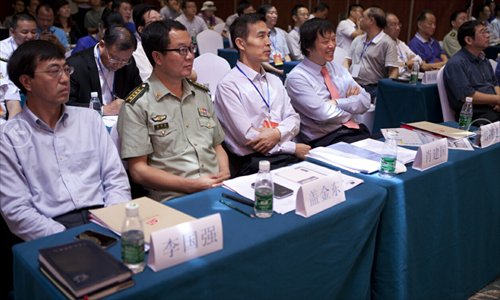Maritime Silk Road key to joint development
Editor's Note:
The new Silk Road initiative envisioned by China, which entails the construction of a Silk Road economic belt as well as the Maritime Silk Road, paints a grand picture of the common development of three continents and helps spread awareness of China's friendly policies toward neighboring countries. However, given the global strategic competition and with disputes in the South China Sea intensifying, there are challenges China must overcome to advance the Silk Road initiative. At a forum hosted by the Global Times which focused on the development of border areas on October 31 in Hainan Province, several experts shared their thoughts.

A group of experts gathered in Hainan at the forum hosted by the Global Times. Photo: Xu Ruoting/GT
Wang Lu, Vice Governor of Hainan Province

Wang Lu
Hainan Province has an important role to play in China's South China Sea strategy, building the 21st-century Maritime Silk Road and developing the country into a maritime power.
In recent years, Hainan has taken full advantage of our maritime resources to develop the province. The province's gross ocean product (GOP) has consecutively achieved two-digit growth. It is estimated that the GOP will reach 115 billion yuan ($18.8 billion) in 2015, accounting for 30 percent of Hainan's GDP, and 286.2 billion yuan in 2020, 35 percent of the total GDP. Hainan is working to be a pioneering area for the implementation of the Maritime Silk Road initiative and to realize the Chinese dream.
Li Guoqiang, deputy director of the Center for Chinese Borderland History and Geography at the Chinese Academy of Social Sciences

Li Guoqiang
Building the Maritime Silk Road is a necessity for China to improve its relations with ASEAN countries.
In the past decade, China-ASEAN ties have enjoyed robust development, but now challenges are mingled with opportunities due to maritime disputes.
The Maritime Silk Road can strengthen China's cooperation with ASEAN countries and lay a sound foundation for improved mutual trust and friendship. The initiative is imperative for China to grow into a maritime power and also for China to safeguard our maritime rights and address disputes with neighboring countries.
While disputes in the South China Sea are now affecting China-ASEAN relations, working together to build the Maritime Silk Road offers constructive options in dealing with these disputes.
In the implementation of the initiative, it's critical to work out strategic targets that can help promote friendship between China and ASEAN countries, instead of only focusing on economic ties.
Wu Shicun, president of the National Institute for South China Sea Studies

Wu Shicun
Securing sovereignty over the South China Sea means a lot to China. This region offers China a shield against invasions.
More importantly, as a maritime nation, China is fully aware that the South China Sea has growing significance as pressure from the US and Japan is making it hard for China to enter the Pacific Ocean through the Yellow Sea and the East China Sea.
Basically, China faces four challenges in the South China Sea.
First, China needs to protect its legitimate rights in these waters. The Chinese navy must act unyieldingly to make sure we don't lose any territories, and we must extend our presence, by means of economic activities or law enforcement.
Second, China is confronted with challenges related to international law, which is now being used by the Philippines to force a compromise. If Manila's appeal is accepted, China may be asked to give up over 790,000 square kilometers of its waters. China made the right choice in not responding to the lawsuit, but it remains uncertain whether other stakeholders such as Vietnam will resort to the same tactic.
Third, the difficulty of enacting and implementing a code of conduct in this region depends on the US. By nature, conflicts in the South China Sea lead to a contention over leadership in this region between China and the US.
Fourth, China lacks a sufficient and powerful say over South China Sea issues. The West has controlled mainstream public discourse and molded an image of China being aggressive. Followed by claimants such as Vietnam and the Philippines, the US has formed a camp to challenge China.
Xiao Jianguo, representative for boundary & ocean affairs, Ministry of Foreign Affairs

Xiao Jianguo
The new leadership of China has attached great importance to the ocean and pinned their hopes of economic development on the sea. As President Xi Jinping emphasized, the Maritime Silk Road is an indispensable part of China's new Silk Road project.
However, there is lots of speculation about China's new Silk Road initiative.
Some have claimed that China is attempting to suppress US strategic space, while there are also concerns that the new Silk Road project will jeopardize cooperation led by ASEAN.
China in fact is aiming to build a community of common interest, in which China and all its neighboring countries work together for common development and prosperity.
We have to enhance our publicity efforts to disperse these suspicions, especially those from our neighboring countries.
Liu Jiangping, senior captain and deputy editor-in-chief of Modern Navy magazine

Liu Jiangping
The 21st-century Maritime Silk Road proposal has great practical significance. It has managed to develop new routes for China's economic transition, and engendered new growth factors for China's modernization.
The new route needs a bridgehead to make sure the project can be carried forward smoothly. Hainan Province must be that bridgehead, which requires the comprehensive development of the navy to secure its potential to be an international port.
But it is not enough just to ensure the security of China's coastal areas. The whole route, crossing the Indian Ocean, the Red Sea and the Mediterranean, faces risks, not just from competitors but also from security threats such as piracy and terrorism. The Chinese navy should play a proactive role in protecting this route.
Li Jie, research fellow at the Naval Military Studies Research Institute

Li Jie
"Joint development" was proposed three decades ago, but has yielded little so far. However, China should continue to uphold the banner of "joint development."
The US and Japan have conducted military deployment to contain China in the South China Sea. In the next stage, the two will join hands to consolidate military deployment. If necessary, they can absolutely encircle China and comprehensively block it.
Their deployment is faster than China's current development of military capabilities to break the blockade. China should develop its own maritime facilities and capabilities, so that related countries are likely to turn to China and seek joint development. Such joint development is the only way that South China Sea disputes will be solved in a peaceful way.
Ge Jianxiong, professor of history and geography at Fudan University

Ge Jianxiong
The initiative to build the Maritime Silk Road is largely based on our needs and it's better not read too much into history.
Looking back, the ancient Chinese transported goods like porcelain and tea to other parts of the world by sea because it was the only option. They actually didn't believe wealth could be made out of the sea. It's critical to have a correct understanding of history when we push ahead this great initiative.